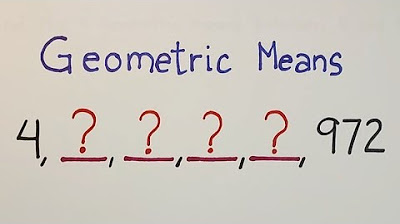Pembahasan soal cerita Barisan dan Deret geometri - kelas 8 SMP/ MTS
Summary
TLDRIn this video, the presenter explains how to solve geometric sequence word problems. Through three examples, the concepts of finding the population in 2015, calculating the growth of bacteria, and determining the original length of a string cut into 4 parts are explored. The video breaks down the steps for calculating geometric series, using formulas to determine the terms and sums of a sequence. The explanations are thorough, with each step shown clearly, making it an excellent resource for students looking to understand geometric sequences and their applications in real-world scenarios.
Takeaways
- 😀 Geometric sequences are used to model various real-life problems, such as population growth, bacteria reproduction, and rope division.
- 😀 The general formula for finding any term in a geometric sequence is: uₙ = u₁ × r^(n-1), where 'uₙ' is the nth term, 'u₁' is the first term, and 'r' is the common ratio.
- 😀 To find the common ratio 'r' in a geometric sequence, divide any term (u₂, u₃, etc.) by its previous term (u₁, u₂, etc.).
- 😀 In the first problem, the population of a region follows a geometric sequence, with the population in 2010 as 640 and in 2011 as 960. The common ratio is 3/2.
- 😀 To find the population in 2015, the formula u₆ = 640 × (3/2)^5 is used, resulting in a population of 4860 people.
- 😀 The bacterial growth problem involves doubling bacteria every 15 minutes. The initial population is 30, and after 2 hours (or 9 intervals), the bacteria count reaches 7680.
- 😀 In problems involving geometric sequences, it's essential to first identify the first term, common ratio, and the number of terms needed for the solution.
- 😀 For the rope cutting problem, the shortest piece of rope is 2 cm, and the longest is 54 cm. The common ratio is found to be 3, and the total length of the rope before cutting is 80 cm.
- 😀 In geometric sequences, the common ratio can be greater than or less than 1, which affects how the sequence progresses (growing or shrinking).
- 😀 The sum of the first n terms of a geometric sequence is calculated using the formula: Sₙ = a × (rⁿ - 1) / (r - 1), where 'Sₙ' is the sum of the first n terms, 'a' is the first term, and 'r' is the common ratio.
Q & A
What is a geometric sequence, and how is it applied in the first problem about population growth?
-A geometric sequence is a sequence where each term after the first is found by multiplying the previous term by a constant called the common ratio. In the population growth problem, the population follows a geometric sequence, with the first term being the population in 2010 and the second term the population in 2011. The common ratio is calculated by dividing the second term by the first, and then the formula for the nth term of the geometric sequence is used to find the population in 2015.
How do you calculate the common ratio (r) in a geometric sequence?
-The common ratio (r) in a geometric sequence is calculated by dividing the second term of the sequence by the first term. In the case of the population problem, r is calculated as 960 (population in 2011) divided by 640 (population in 2010), resulting in a ratio of 3/2.
Why is the formula for the nth term of a geometric sequence written as u_n = a * r^(n-1)?
-The formula for the nth term of a geometric sequence, u_n = a * r^(n-1), comes from the definition of a geometric progression, where each term is the previous term multiplied by the common ratio. 'a' represents the first term, 'r' is the common ratio, and 'n' is the term number. The exponent (n-1) accounts for the number of times the common ratio is multiplied to the first term to reach the nth term.
How do you find the total population in 2015 if the population follows a geometric sequence?
-To find the population in 2015, you use the formula for the nth term of a geometric sequence. In this case, the first term is 640 (the population in 2010), the common ratio is 3/2, and the term number for 2015 is 6. By substituting these values into the formula u_6 = 640 * (3/2)^(6-1), we get the population in 2015 as 4860.
In the bacterial growth problem, why is the term n calculated as 9?
-In the bacterial growth problem, the bacteria double every 15 minutes. The total time is 2 hours, which is 120 minutes. Since each doubling period is 15 minutes, we calculate the number of periods by dividing 120 by 15, which gives 8. However, because the initial count of 30 is at the beginning (at time 0), we add 1 to account for the first period, resulting in n = 9.
How do you calculate the number of bacteria after 2 hours?
-To calculate the number of bacteria after 2 hours, use the formula for the nth term of a geometric sequence. The first term (u_1) is 30 (the initial bacteria count), the common ratio (r) is 2 (since the bacteria double every 15 minutes), and n = 9 (since there are 9 periods of doubling). Using the formula u_n = 30 * 2^(9-1) = 30 * 2^8 = 7680, we find that the number of bacteria after 2 hours is 7680.
What is the significance of the ratio being greater than 1 in the string cutting problem?
-In the string cutting problem, the ratio is greater than 1 (r = 3), which means the lengths of the parts increase as you move from the shortest to the longest. This is a characteristic of a geometric sequence where the common ratio is greater than 1. The formula for the sum of the first n terms is used to find the total length of the string before it was cut.
How do you find the total length of the string before it was cut into parts?
-To find the total length of the string before it was cut, you use the sum formula for a geometric sequence: S_n = a * (r^n - 1) / (r - 1). In this case, the first part is 2 cm (a = 2), the ratio is 3, and there are 4 parts (n = 4). By substituting these values into the formula, we get S_4 = 2 * (3^4 - 1) / (3 - 1) = 80, so the total length of the string is 80 cm.
What is the sum formula for a geometric sequence, and when is it used?
-The sum formula for a geometric sequence is used to find the total sum of the first n terms. It is written as S_n = a * (r^n - 1) / (r - 1), where 'a' is the first term, 'r' is the common ratio, and 'n' is the number of terms. This formula is used when you need to calculate the sum of multiple terms in the sequence, such as finding the total length of a string before it was cut.
How does the calculation for the bacterial growth problem differ from the string cutting problem?
-The calculation for bacterial growth focuses on finding the number of bacteria after a certain time, where the sequence follows a doubling pattern (common ratio of 2), and uses the formula for the nth term of a geometric sequence. In contrast, the string cutting problem involves finding the total length of the string before it was cut, using the sum formula of a geometric sequence. The main difference lies in whether you are calculating a specific term or the sum of terms.
Outlines

This section is available to paid users only. Please upgrade to access this part.
Upgrade NowMindmap

This section is available to paid users only. Please upgrade to access this part.
Upgrade NowKeywords

This section is available to paid users only. Please upgrade to access this part.
Upgrade NowHighlights

This section is available to paid users only. Please upgrade to access this part.
Upgrade NowTranscripts

This section is available to paid users only. Please upgrade to access this part.
Upgrade NowBrowse More Related Video

Baris dan Deret Geometri | Matematika Kelas X Fase E Kurikulum Merdeka

GEOMETRIC SEQUENCE || GRADE 10 MATHEMATICS Q1

Barisan dan Deret Bagian 3 - Barisan Geometri Matematika Wajib Kelas 11

How to Find the Geometric Means? Geometric Sequence - Grade 10 Math

Pre-Calculus : GEOMETRIC SEQUENCE

Arithmetic Sequences and Arithmetic Series - Basic Introduction
5.0 / 5 (0 votes)